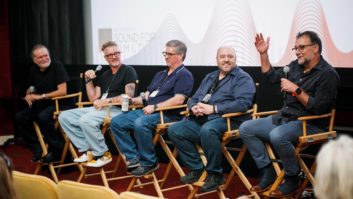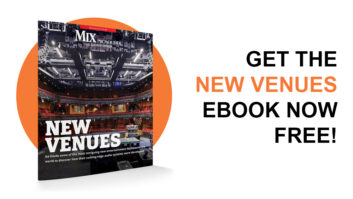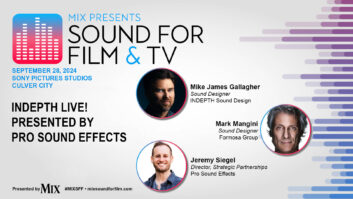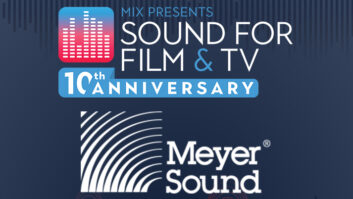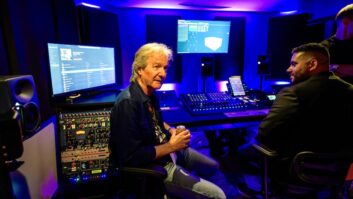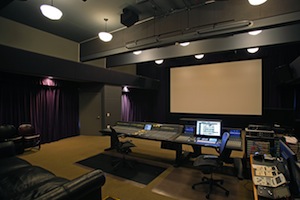
Four-time Oscar-nominated music mixer Dennis S. Sands has taken his extensive experience and expertise in orchestral recording and film score mixing and brought it all to bear in the creation of his magnificent home-based facility, Sound Waves SB, the first private mix facility we know of to be equipped with the Dolby Atmos system.
With an engineering/mixing resume that includes landmark films such as The Shawshank Redemption, Good Will Hunting, Independence Day, The Horse Whisperer, and Who Framed Roger Rabbit, plus current blockbusters such as Captain America—The First Avenger and Godzilla 2014. His Oscar nominations for Best Achievement In Sound Mixing include Forrest Gump, Contact, Cast Away and The Polar Express. He has six additional C.A.S, Golden Reel, and Satellite Award nominations, plus a Grammy for Best Score Soundtrack Album for the film American Beauty.
Always looking to bring his art to a higher level, Sands was recently introduced to the Dolby Atmos immersive platform at an L.A. dub stage, and immediately recognized its potential. He went home and re-outfitted his already impressive studio, enabling him to deliver a film score in Atmos, 5.1, 7.1, and stereo.
The facility itself has an impressive pedigree, too. Originally built by action-film director Andrew Davis (The Fugitive), the studio, now known as Sound Waves SB, was designed by Tomlinson Holman and outfitted from top to bottom by RSPE Audio Solutions of Los Angeles, in conjunction with Ron Lagerlof of Visioneering Design.
The SB stands for Santa Barbara, Sands’ beautiful and peaceful getaway from the rush of Hollywood.
Here’s what Sands has to say about his new mixing home.
What kind of experience can clients expect when they come to Sound Waves SB?
Everyone who comes here is blown away by it. First, it’s extremely comfortable and very private. It’s relaxed, it’s beautiful, and the facility is unique in the music world—there’s nothing like it anywhere. It’s also extremely well equipped—with great sound and a product that translates very well.
Plus, we have great projection: a Christie Digital Systems projector, a 12” by 20” screen, and a full Meyer Sound cinema sound system. It’s a very large space (42×36 feet, with 16-foot ceiling), and both RSPE and Visioneering were initially contracted by Andy (Davis) and have been involved with this facility since its start. RSPE supplied the equipment, Ron Lagerlof the technical expertise to interface it all—and they both provided the same capabilities for me.
And finally, we’re in Santa Barbara, which is a resort destination. We have a huge lawn here with benches, so we can sit outside and have lunch. There’s also great food and luxury hotels—Santa Barbara is all about accommodating visitors.
Let’s talk about Dolby Atmos. Does it change the way you mike an orchestra?
I’m experimenting a little now, but I haven’t found anything that I would do radically different…as yet. Just to backtrack a bit as to why I put Atmos in my facility: at the end of December 2012, I was working on a project called Oz the Great and Powerful. The director contacted me and said that they were going to release the movie in an immersive format and wanted me to listen to it, because they wanted me to do something for the score I said okay, but I was very cynical about it. I thought, “Boy, 5.1 or 7.1 is pretty nice, why do we need another format?”
So I went to a dub stage in L.A. where they had an Atmos demo set up. The first time I heard this stuff—and no one was more cynical than I was—the first time I heard it I was completely blown away. “Immersive” is a very good term. The sound isn’t thrown at you; you’re in it, in a great, great way. Not only that, but the clarity, the depth, the accuracy of the movement of sound, and the placement of sound in the 3-dimensional environment, was stunning—something I’d never heard before, really.
So I started to look into it. But at the time, outside of going to a dub stage, I had no way of hearing it, and certainly no way of mixing music with it. There was just nowhere to go, and now I have the only dedicated music-mixing facility with Atmos capability. There simply are no other facilities.
What about the overhead speakers? How do they figure into the way you mix?
I look at the overhead speakers the way I look at a subwoofer. I think what makes the overheads work is when you use then occasionally. If you use them all the time, they’ll disappear. Subwoofers are the same thing. If you have a low-frequency thing going on all the time, it loses its effectiveness. When the overheads are there occasionally, then it opens up—it’s impressive and beautiful.
One of the great things about Atmos is that the surround channels are full range and of equivalent volume to the screen channels. All speakers are set to the same standard level, plus, the surround channels are bass-managed, which means I have subwoofers that enhance the low frequencies on the surround channels and the ceiling channels. You now have full audio range throughout the entire theater, which you never had before. It’s a totally different soundscape. And because it’s so accurate in terms of how you can position various musical elements in a space, it’s really an incredible experience for the audience—a new experience.

Sands’ monitoring system is anchored by three Meyer Sound Acheron 80 screen channel loudspeakers and two X-800C high-power and X-400C cinema subwoofers each. Perimeter and overhead reinforcement comprises 14 HMS-10 and 10 HMS-12 surround loudspeakers, while a Galileo loudspeaker management system with one Galileo 408 processor supplies drive and equalization. The system was designed and installed by Ron Lagerlof in consultation with Andy Potvin of Dolby Laboratories.
Photo: Russ Belttary/Dennis Sands
So Atmos leaves a lot more room for Foley…
As well as the dialog. Instead of being locked to the screen, you can spread the width of the music to the walls and still have full frequency-range capability. It allows more space for dialog, more space for sound effects, and you can still keep the music happening—there’s just less competition for space. In essence, you can move sound off of the screen.
Do you think Atmos will change the way composers work?
I hope so. What I would love to see happen is for composers to a) get excited about this format, and b) think about it when they’re composing, so they actually start writing for this kind of experience. People who are creative, I think, will find this a wonderfully additive tool.
What else do you have here at Sound Waves SB?
One thing that is substantially helpful to me, especially in the interface of my Atmos mixing, is the Euphonix System 5 MC that I got from Russ at RSPE. It’s a control surface that’s just absolutely spectacular and is an integral part of Atmos control for our studio.
When I moved here, I had a Euphonix CS 3000, a 96-input desk, which is digitally controlled analog. I looked at several digital consoles, but they are limited to a 96k maximum format. I do all of my orchestral and/or acoustic recording at 192k. The difference from 96k to 192k is stunning. The quality, the dimensionality, the depth of the sound, the content, the richness, is stunningly better at 192k. But the limitation of digital consoles is that everything you do, whether you set up a channel, effects send, EQ, compressor, whatever, draws on the available DSP. From a practical standpoint, you cannot go above 96k on a digital console, so I chose to keep my analog console to allow for the highest possible quality.
Because I kept my CS 3000, I can remain in the 192k format, which means the quality is substantially better, but I need to access my other systems. I have four systems online when I mix: one for prelay, one for orchestra, one is the mix rig, and the fourth is a dedicated video system.
With the System 5 MC, everything is right in front of me. At the push of a button I access whatever system I want, do my moves, save ’em, push a button, go to a different system, it’s all right there—just fantastic.
For more information on Dennis Sands and Sound Waves SB, visit www.soundwavessb.com. For more information on RSPE Audio, visit www.rspeaudio.com.
Editor’s note: While he may be at ease with miking horns, Sands is not the kind of person who’s comfortable with blowing his own. So we asked Gary Lux, former head scoring mixer at Universal Studios, to close the interview.
Lux: I recently visited Dennis at his studio in Santa Barbara where he demonstrated a Dolby Atmos mix he had done for the then-upcoming movie Godzilla. I’ve mixed a tremendous amount of music in 5.1, but hearing his Dolby Atmos mix blew me away, as it opened my mind to the possibilities I had tried to achieve in 5.1 for so long. But, the real magic to Dennis, besides the talent and his wonderful ear, is how incredibly nice a man he is, which makes him one of the greatest music mixers this town has ever known.
